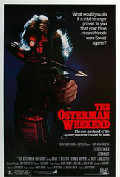
Directed by
Sam Peckinpah
116 minutes
Rated R
Reviewed by
David Michael Brown

The Osterman Weekend
Synopsis: Newsreader John Tanner (Rutger Hauer) is getting ready for his yearly get together with three of his oldest friends and their families. But he is shocked when he is told by Lawrence Fassett (John Hurt) that his friends are in fact spies. They join forces using an elaborate system of surveillance equipment to trap the spies at Tanner’s house but he soon discovers that Fassett may not be all he seems as his house is besieged by SWAT teams intent in killing the enemy. Problem is, Tanner doesn’t know who that really is.Sam Peckinpah wanted The Osterman Weekend, based on a Robert Ludlum novel, to be his big comeback feature after the awful trucker movie, Convoy (1978) a blemish on an otherwise illustrious career. Ill of health he soldiered through filming this, his final film, despite major battles with the film’s producers and the studio and produced an enthralling thriller and a hatchet job on the television industry.
The set pieces, as you would expect from Peckinpah, are awesome. This is the man who reinvented the Western for modern audiences. Leone and Carbucci may have bloodied the genre with their Spaghetti Westerns but it was The Wild Bunch (1969) that brought the genre back to the US after years in the wilderness. When people are shot in a Peckinpah film you feel it, the violence is palpable. The Osterman Weekend uses every trick in Peckinpah’s extensive book, slow motion being used a bit too often, but the scene around the flaming swimming pool is thrilling to behold as Hauer rises from the water, crossbow in hand.
The cast is an 80s who’s who of video stars. Rutger Hauer handles his first attempt as a Hollywood leading man with aplomb after his breakthrough performance in Paul Verhoeven’s Soldier Orange. He shows much of the prowess he would eventually show in his finest role as the android Roy Batty in Ridley Scott’s Blade Runner. John Hurt, Craig. T. Nelson and Chris Sarandon as the three friends, exude a spiky edginess as the group desperately try to figure out whom they can trust. Burt Lancaster is suitably elegant as the sinister Maxwell Danforth.
The use of television and surveillance equipment looks a bit dated now but was state of the art back in the early 80s. The ending is also a bit clichéd but this was made when video tape had barely registered in the world’s psyche and this was angry (old) man stuff, a condemnation of the authorities, corporations and a society where television is king - thinking about it - pretty much like the present day.

Want more about this film?


Want something different?




